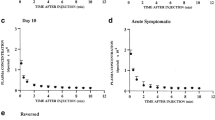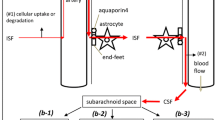Abstract
In order to assess the involvement of blood-brain barrier (BBB) breakdown in the pathogenesis of thiamine deficiency encephalopathy, autologous albumin immunohistochemistry was performed in mice which were rendered thiamine-deficient by pyrithiamine, a BBB-permeant antagonist of thiamine. In the presymptomatic animals until day 8 of the treatment, histological lesions were not detected by H&E staining. However, localized staining of albumin was evident, suggesting an extravascular leakage of the endogenous intravascular protein. On day 10 of thiamine deficiency, when neurological signs appeared, both histological lesions and massive albumin extravasation were demonstrated in all the animals. The BBB breakdown was only occasionally observed in the brains of mice treated with oxythiamine, a BBB-impermeant antagonist or in control animals. These results suggest that BBB breakdown is not only a phenomenon secondary to tissue destruction, but it is more directly involved in the pathogenesis of thiamine deficiency encephalopathy.
Similar content being viewed by others
References
Aikawa, H., Watanabe, I., Furuse, T., Iwasaki, Y., Satoyoshi, E., Sumi, T. and Moroji, T. (1984). Low energy levels in thiamine-deficient encephalopathy.J. Neuropathol. Exp. Neurol. 43:276–287.
Brightman, M. W. and Reese, T. S. (1969). Junctions between intimately apposed cell membranes in the vertebrate brain.J. Cell Biol. 40:648–677.
Butterworth, R. F. (1986). Cerebral thiamine-dependent enzyme changes in experimental Wernicke's encephalopathy.Metab. Brain Dis. 1:165–175.
Butterworth, R. F., Giguere, J.-F. and Besnard, A.-M. (1986). Activities of thiamine-dependent enzymes in two experimental models of thiamine-deficiency encephalopathy: 2. α-Ketoglutarate dehydrogenase.Neurochem. Res. 11:567–577.
Collins, G. H. (1967). Glial cell changes in the brain stem of thiamine-deficient rats.Am. J. Pathol. 50: 791–817.
DeBault, L. E. and Cancilla, P. A. (1980). γ-Glutamyl transpeptidase in isolated brain endothelial cells: Induction by glial cellsin vitro.Science 207:653–655.
Dermietzel, R. and Krause, D. (1991). Molecular anatomy of the blood-brain barrier as defined by immunocytochemistry.Int. Rev. Cytol. 127:57–109.
Dreyfus, P. M. (1961). The quantitative histochemical distribution of thiamine in the deficient rat brain.J. Neurochem. 8:139–145.
Dreyfus, P. M. (1965). The regional distribution of transketolase in the normal and the thiamine deficient nervous system.J. Neuropathol. Expl. Neurol. 24:119–129.
Giguere, J.-F. and Butterworth, R. F. (1987). Activities of thiamine-dependent enzymes in two experimental models of thiamine deficiency encephalopathy: 3. Transketolase.Neurochem. Res. 12:305–310.
Greenwood, J. (1991). Mechanisms of blood-brain barrier breakdown.Neuroradiology 33:95–100.
Harata, N., Iwasaki, Y. and Ohara, Y. (1993). Reappraisal of regional thiamine content in the central nervous system of the normal and thiamine-deficient mice.Metab. Brain Dis. 8:45–59.
Hsu, S. M., Raine, L. and Fanger, H. (1981). Use of avidin-biotin-peroxidase complex (ABC) in immunoperoxidase techniques: A comparison between ABC and unlabeled antibody (PAP) procedures.J. Histochem. Cytochem. 29:577–580.
Iizuka, H., Yamamoto, H., Iwasaki, Y., Yamamoto, T. and Konno, H. (1987). Evolution of tissue damage in compressive spinal cord injury in rats.J. Neurosurg. 66:595–603.
Janzer, R. C. and Raff, M. C. (1987). Astrocytes induce blood-brain barrier properties in endothelial cells.Nature 325:253–257.
Juhler, M., Laursen, H. and Barry, D. I. (1986). The distribution of immunoglobulins and albumin in the central nervous system in acute experimental allergic encephalomyelitis.Acta Neurol. Scand. 73:119–124.
Manz, H. J. and Robertson, D. M. (1972). Vascular permeability to horseradish peroxidase in brainstem lesions of thiamine-deficient rats.Am. J. Pathol. 66:565–576.
Phillips, S. C. and Cragg, B. G. (1984). Blood-brain barrier dysfunction in thiamine-deficient, alcohol-treated rats.Acta Neuropathol. (Berl) 62:235–241.
Pincus, J. H. and Grove, I. (1970). Distribution of thiamine phosphate esters in normal and thiamine-deficient brain.Exp. Neurol. 28:477–483.
Reese, T. S. and Karnovsky, M. J. (1967). Fine structural localization of a blood-brain barrier to exogenous peroxidase.J. Cell Biol. 34:207–217.
Robertson, D. M. and Manz, H. J. (1971). Effect of thiamine deficiency on the competence of the blood-brain barrier to albumin labeled with fluorescent dyes.Am. J. Pathol. 63:393–402.
Rubin, L. L., Hall, D. E., Porter, S., Barbu, K., Cannon, C., Horner, H. C.et al. (1991). A cell culture model of the blood-brain barrier.J. Cell Biol. 115:1725–1735.
Schroth, G., Wichmann, W. and Valavanis, A. (1991). Blood-brain-barrier disruption in acute Wernicke encephalopathy: MR findings.J. Comput. Assist. Tomogr. 15:1059–1061.
Stewart, P. A. and Wiley, M. J. (1981). Developing nervous tissue induces formation of blood-brain barrier characteristics in invading endothelial cells: A study using quail-chick transplantation chimeras.Dev. Biol. 84:183–192.
Suzuki, M., Iwasaki, Y., Yamamoto, T., Konno, H. and Kudo, H. (1988). Sequelae of the osmotic blood-brain barrier opening in rats.J. Neurosurg. 69:421–428.
Tanno, H., Nockels, R. P., Pitts, L. H. and Noble, L. J. (1992a). Breakdown of the blood-brain barrier after fluid percussive brain injury in the rat. Part 1: Distribution and time course of protein extravasation.J. Neurotrauma 9:21–32.
Tanno, H., Nockels, R. P., Pitts, L. H. and Noble, L. J. (1992b). Breakdown of the blood-brain barrier after fluid percussive brain injury in the rat. Part 2: Effect of hypoxia on permeability to plasma proteins.J. Neurotrauma 9:335–347.
Troncoso, J. C., Johnston, M. V., Hess, K. M., Griffin, J. W. and Price, D. L. (1981). Model of Wernicke's encephalopathy.Arch. Neurol. 38:350–354.
Victor, M., Adams, R. D. and Collins, G. H. (1989).The Wernicke-Korsakoff syndrome and related neurologic disorders due to alcoholism and malnutrition., F. A. Davis, Philadelphia, pp. 61–112.
Warnock, L. G. and Burkhalter, V. J. (1968). Evidence of malfunctioning blood-brain barrier in experimental thiamine deficiency in rats.J. Nutr. 94:256–260.
Watanabe, I. (1978). Pyrithiamine-induced acute thiamine-deficient encephalopathy in the mouse.Exp. Mol. Pathol. 28:381–394.
Wooley, D. W. and White, A. G. C. (1943). Production of thiamine deficiency disease by the feeding of pyridine analogue of thiamine.J. Biol. Chem. 189:285–289.
Author information
Authors and Affiliations
Rights and permissions
About this article
Cite this article
Harata, N., Iwasaki, Y. Evidence for early blood-brain barrier breakdown in experimental thiamine deficiency in the mouse. Metab Brain Dis 10, 159–174 (1995). https://doi.org/10.1007/BF01991863
Received:
Accepted:
Issue Date:
DOI: https://doi.org/10.1007/BF01991863




